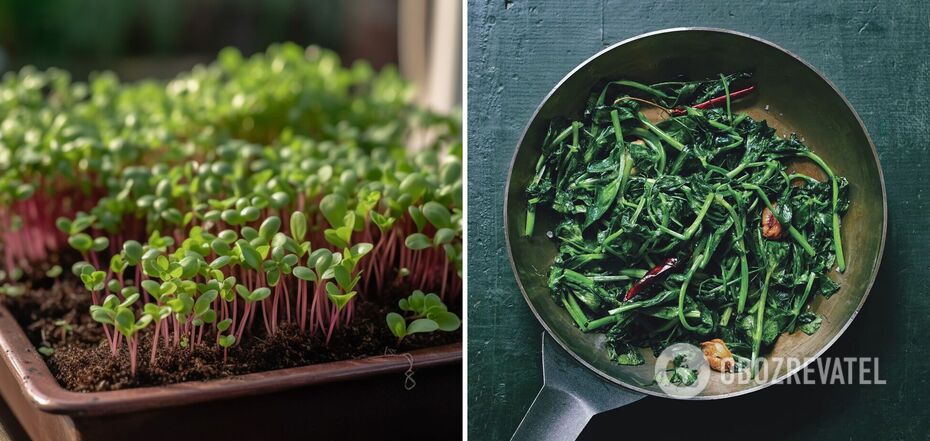Life
What is a microgrin and what kinds taste best: instructions, how to plant
Edible plant sprouts have long been an integral part of Asian cuisine. The inhabitants of the Eastern continent have noticed that the barely sprouted grains bring the body almost double benefits and have a special delicate taste. Now this ingredient has also gained a foothold in modern European cuisine, having been called microgreen.
OBOZREVATEL tells more about the benefits of microgreen. And about how to grow it on your windowsill, which is easy enough and does not require gardening skills.
What is useful for microgreen
At the moment when the seed is just breaking out of the soil, the concentration of nutrients in the young plant is the highest. It is just forming and therefore uses all the stock that was in the seeds. It is at this time that the proteins, vitamins, and minerals contained in the stem are in the easiest form to absorb.
What counts as microgreens
It is best to consume plants whose stems have reached only a few inches in height and have only formed 2-3 leaves. It usually takes 4 to 7 days for the seeds to germinate to this stage, depending on the crop. And you can grow both traditional greens (rucola, different salads) and cereals and legumes (wheat, soybeans) and even vegetables (beets, cabbage, radishes).
How to grow microgreens
In order to germinate the grains of edible plants, you need to take any material that can serve as a substrate - absorbent cotton, multi-layer gauze, paper towels, special mats made of plant fiber, or ordinary soil. You can germinate seeds in a jar or canvas bag. The easiest way is to buy a ready-made kit, including a mini greenhouse, substrate, seed packet, and instructions.
To grow a microgreen on cotton, paper, or plant fiber mats, you need to spread the substrate on a flat surface, evenly scatter the seeds on it, water everything well to make the substrate damp, and sprinkle it daily to maintain the level of moisture. In a few days from such an improvised bed you can harvest. Similarly, the grains are germinated in the ground.
In a jar, the seeds are sprouted as follows - in a thoroughly washed jar, the seeds are poured into a quarter of the volume, which are poured with warm water, covered with gauze, and left to soak for a few hours, for example, overnight. In the morning, the old water is drained, and the seeds are washed and put under the gauze again. The washing procedure is repeated 2-3 times a day.
To grow grains in a cloth, you need to put washed grains into a baggie and soak it in warm water twice a day for about a minute, and then place it in a way that excess water drains off it, such as hanging it up. After a few minutes, the sack should be placed in any convenient place. A well-lit windowsill is ideal.
What can be grown as a microgreen
Here are what crops are suitable for germination at home.
Sunflowers
You can germinate as peeled uncooked seeds, and in the husk, in which case they will germinate longer - not 2-3 days, but about a week. Such shoots contain protein vitamins A, B, C, K, E, and D, as well as manganese, zinc, iron, and calcium.
Beets
It is best to sow beet seeds in the ground or mats. The sprouts will be ready in 6-8 days and will provide your diet with vitamins A, C, and E and minerals such as potassium and magnesium.
Wheat
Sprouted shoots are considered ready to eat when the white sprouts reach grain length. And this is about 3 to 4 days after sowing. Wheat microgreens are a potent source of vitamins A, B, C, and E, calcium, phosphorus, iron, niacin, thiamine, and pantothenic acid.
Cress lettuce.
This leafy crop requires a lot of light to germinate, so its seeds are simply scattered on the ground or other substrate and not covered at all or covered with a transparent greenhouse. In 5-7 days you will get a microgreen rich in vitamins A, B, C, and K, calcium, iodine, manganese, iron, and zinc.
Mung bean or mung bean.
The sprouts of this legume crop are ready for consumption as early as days 2-4. They can be sprouted by any method. Mung bean contains a lot of vitamins A, B, C, E, K, calcium, magnesium, zinc, fiber, and protein.
Cabbage crops
Cabbage is one of the healthiest vegetables, and its shoots contain an increased dose of vitamins A, C, B, fiber, protein, iron, magnesium, calcium, and potassium. It takes 6-8 days to get the product ready to eat.
Alfalfa
To get micro grass with vitamins A, E, and B, iron, calcium, and magnesium in your diet, you can grow alfalfa. The crop can be harvested 5-7 days after sowing.
Soybean
This plant will provide your meals with protein, vitamins A, B, C, and K, as well as phosphorus, copper, potassium, iron, manganese, and magnesium. It contains soybean micro grain and unsaturated fatty acids and fiber. It takes four to six days to germinate.
How to Store and Consume Microgreens
You can eat the pruned shoots immediately after picking them, or you can dry them well and store them in the refrigerator in any sealed container. This way they will remain edible for up to a week.
In addition to being added to salads, microgreens can also be used to make smoothies. It is also stewed with meat or vegetables, like soy sprouts, or lightly fried and used in addition to regular side dishes.
Previously OBOZREVATEL told us what to plant in the garden so that almost do not take care of plants and have a good harvest.
Subscribe to the channels OBOZREVATEL in Telegram and Viber to keep up with the latest developments.



























